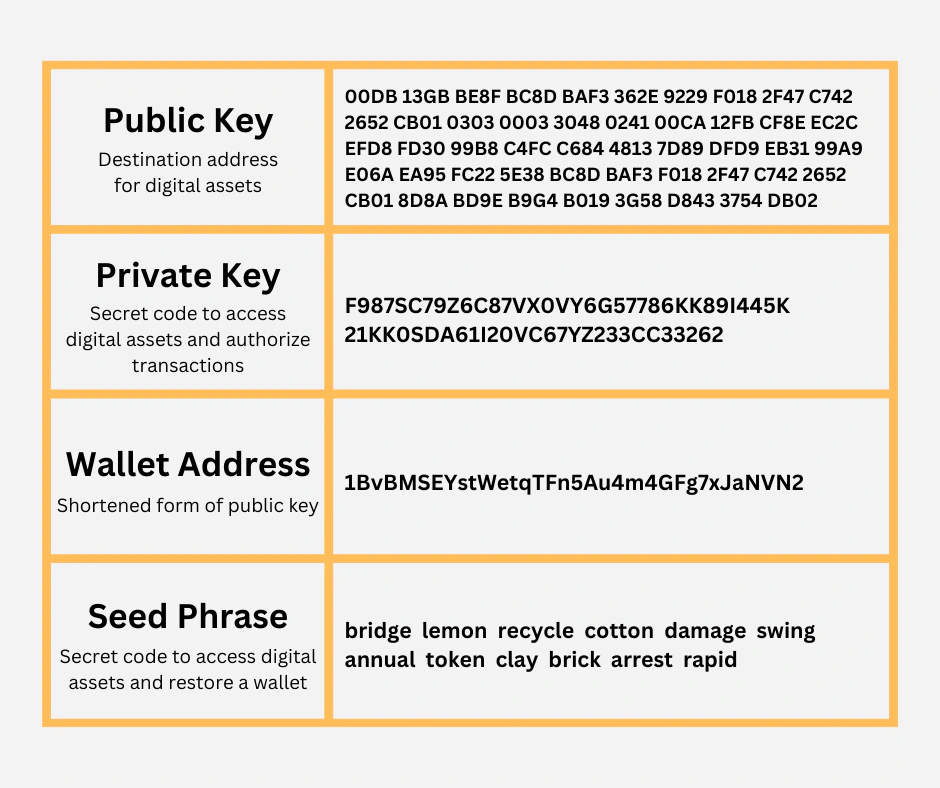In the decentralized world of Bitcoin, having control over your private keys is paramount. Unlike traditional financial systems where banks hold and manage your money, Bitcoin empowers you to be your own bank.
One of the essential skills every Bitcoin enthusiast should master is how to import Bitcoin private keys into a wallet. This guide will walk you through the process, ensuring you can access your bitcoin securely and efficiently.
Import Bitcoin Wallet with Private Keys: Understanding The Process
Before diving into the import process, it’s crucial to understand what a private key is. In the simplest terms, a private key is a secret string of characters (numbers and letters) that allows you to spend your bitcoin.
It is a critical component of Bitcoin’s cryptographic security system, ensuring that only you have access to your funds.
Nowadays, private keys are often backed up as mnemonic phrases also called “seed phrases” or “recovery words/phrase”, typically consisting of 12 or 24 words that are human readable.

A Bitcoin wallet, on the other hand, is a software program that stores your private keys and interacts with the Bitcoin blockchain.
Wallets come in various forms, including hardware wallets, software wallets, mobile wallets, and paper wallets. Regardless of the type, the private keys remain the fundamental element that grants access to your bitcoin.
Related: How to Send Bitcoin to Another Wallet
Why Import Bitcoin Wallet Using a Private Key?
There are several scenarios where you might need to import a Bitcoin wallet using a private key:
- Switching Wallets: You might want to switch from one wallet provider to another for better security features, user experience, or additional functionality.
- Recovering Access: If you’ve lost access to your original wallet but have the private keys, importing them into a new wallet allows you to regain control over your funds.
- Consolidating Funds: You may have multiple wallets and wish to consolidate your bitcoin into a single wallet for easier management.
Steps to Import Bitcoin Private Keys
1. Choose a Wallet
First, choose a wallet that supports the import of private keys. Many wallets offer this feature, including popular ones like Sparrow, Electrum, or Specter, and various mobile wallets such as Zeus or Mutiny.
Ensure you download the wallet from a reputable source to avoid malware or phishing attacks.
2. Install and Set Up the Wallet
Download and install the chosen wallet on your device. Follow the setup instructions, which typically involve creating a new wallet. During the setup process, the wallet may prompt you to back up your new wallet’s private keys or recovery phrases.
It’s essential to do this as an extra layer of security.
3. Locate the Import Feature
Once the wallet is set up, look for the feature that allows you to import a private key.
This option is usually found in the settings or advanced settings menu. The terminology may vary between wallets, so keep an eye out for terms like “Import Private Key,” “Sweep Private Key,” or simply “Import.”
Its important to note the differences between “Import private key” function and “Sweep private key” function. The import function simply adds the private key to the list of private keys your wallet controls.
“Sweep private key” function moves existing funds from that private key to a private key that your current wallet controls. This function will incur fees as funds will be moved.
4. Enter Your Private Key
When prompted, enter your private key. Private keys can be represented in several formats, such as hexadecimal or WIF (Wallet Import Format).
Ensure you enter the key correctly. Some wallets might also allow you to scan a QR code if your private key is in that format.
5. Confirm and Import
After entering your private key, the wallet will usually ask for confirmation. Review the details and confirm the import. The wallet will then process the key and import it, making it and the funds it holds available within the wallet interface.
6. Secure Your Wallet
Security is paramount. Once your bitcoin is imported, take steps to secure your wallet.
This includes setting a strong password, enabling two-factor authentication (if available), and backing up your wallet’s new private keys or recovery phrases. For hardware wallets, ensure they are stored in a safe place.
Best Practices for Managing Your Private Keys
- Never Share Your Private Key: Your private key is the key to your bitcoin. Sharing it with others is a sure way of losing funds.
- Use Cold Storage for Large Amounts: For significant amounts of bitcoin, consider using cold storage solutions like hardware wallets which are not connected to the internet and therefore less vulnerable to hacks.
- Regular Backups: Regularly back up your wallet and private keys. Store these backups in multiple secure locations to mitigate the risk of loss.
- Stay Informed: Keep up to date with the latest security practices and wallet updates. The Bitcoin ecosystem continually evolves, and staying informed will help you better protect your assets.
Conclusion
Importing a Bitcoin wallet using a private key is a fundamental skill that enhances your control over your bitcoin.
Whether you are recovering lost access, switching wallets, or consolidating funds, this process ensures that you can always maintain access to your bitcoin.
By following the steps outlined in this guide and adhering to best security practices, you can navigate the world of Bitcoin with confidence and peace of mind.










